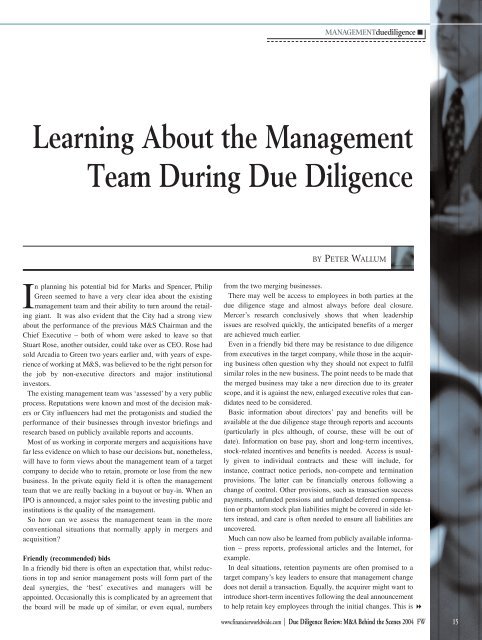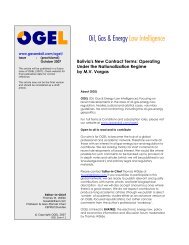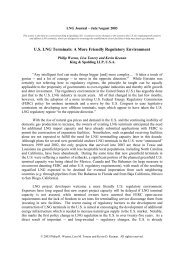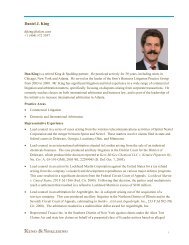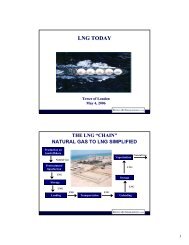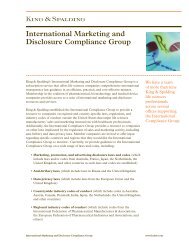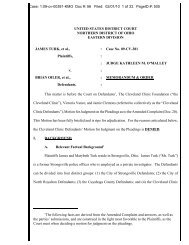Due Diligence Review: M&A Behind the Scenes - King & Spalding
Due Diligence Review: M&A Behind the Scenes - King & Spalding
Due Diligence Review: M&A Behind the Scenes - King & Spalding
You also want an ePaper? Increase the reach of your titles
YUMPU automatically turns print PDFs into web optimized ePapers that Google loves.
MANAGEMENTduediligence<br />
Learning About <strong>the</strong> Management<br />
Team During <strong>Due</strong> <strong>Diligence</strong><br />
BY PETER WALLUM<br />
In planning his potential bid for Marks and Spencer, Philip<br />
Green seemed to have a very clear idea about <strong>the</strong> existing<br />
management team and <strong>the</strong>ir ability to turn around <strong>the</strong> retailing<br />
giant. It was also evident that <strong>the</strong> City had a strong view<br />
about <strong>the</strong> performance of <strong>the</strong> previous M&S Chairman and <strong>the</strong><br />
Chief Executive – both of whom were asked to leave so that<br />
Stuart Rose, ano<strong>the</strong>r outsider, could take over as CEO. Rose had<br />
sold Arcadia to Green two years earlier and, with years of experience<br />
of working at M&S, was believed to be <strong>the</strong> right person for<br />
<strong>the</strong> job by non-executive directors and major institutional<br />
investors.<br />
The existing management team was ‘assessed’ by a very public<br />
process. Reputations were known and most of <strong>the</strong> decision makers<br />
or City influencers had met <strong>the</strong> protagonists and studied <strong>the</strong><br />
performance of <strong>the</strong>ir businesses through investor briefings and<br />
research based on publicly available reports and accounts.<br />
Most of us working in corporate mergers and acquisitions have<br />
far less evidence on which to base our decisions but, none<strong>the</strong>less,<br />
will have to form views about <strong>the</strong> management team of a target<br />
company to decide who to retain, promote or lose from <strong>the</strong> new<br />
business. In <strong>the</strong> private equity field it is often <strong>the</strong> management<br />
team that we are really backing in a buyout or buy-in. When an<br />
IPO is announced, a major sales point to <strong>the</strong> investing public and<br />
institutions is <strong>the</strong> quality of <strong>the</strong> management.<br />
So how can we assess <strong>the</strong> management team in <strong>the</strong> more<br />
conventional situations that normally apply in mergers and<br />
acquisition?<br />
Friendly (recommended) bids<br />
In a friendly bid <strong>the</strong>re is often an expectation that, whilst reductions<br />
in top and senior management posts will form part of <strong>the</strong><br />
deal synergies, <strong>the</strong> ‘best’ executives and managers will be<br />
appointed. Occasionally this is complicated by an agreement that<br />
<strong>the</strong> board will be made up of similar, or even equal, numbers<br />
from <strong>the</strong> two merging businesses.<br />
There may well be access to employees in both parties at <strong>the</strong><br />
due diligence stage and almost always before deal closure.<br />
Mercer’s research conclusively shows that when leadership<br />
issues are resolved quickly, <strong>the</strong> anticipated benefits of a merger<br />
are achieved much earlier.<br />
Even in a friendly bid <strong>the</strong>re may be resistance to due diligence<br />
from executives in <strong>the</strong> target company, while those in <strong>the</strong> acquiring<br />
business often question why <strong>the</strong>y should not expect to fulfil<br />
similar roles in <strong>the</strong> new business. The point needs to be made that<br />
<strong>the</strong> merged business may take a new direction due to its greater<br />
scope, and it is against <strong>the</strong> new, enlarged executive roles that candidates<br />
need to be considered.<br />
Basic information about directors’ pay and benefits will be<br />
available at <strong>the</strong> due diligence stage through reports and accounts<br />
(particularly in plcs although, of course, <strong>the</strong>se will be out of<br />
date). Information on base pay, short and long-term incentives,<br />
stock-related incentives and benefits is needed. Access is usually<br />
given to individual contracts and <strong>the</strong>se will include, for<br />
instance, contract notice periods, non-compete and termination<br />
provisions. The latter can be financially onerous following a<br />
change of control. O<strong>the</strong>r provisions, such as transaction success<br />
payments, unfunded pensions and unfunded deferred compensation<br />
or phantom stock plan liabilities might be covered in side letters<br />
instead, and care is often needed to ensure all liabilities are<br />
uncovered.<br />
Much can now also be learned from publicly available information<br />
– press reports, professional articles and <strong>the</strong> Internet, for<br />
example.<br />
In deal situations, retention payments are often promised to a<br />
target company’s key leaders to ensure that management change<br />
does not derail a transaction. Equally, <strong>the</strong> acquirer might want to<br />
introduce short-term incentives following <strong>the</strong> deal announcement<br />
to help retain key employees through <strong>the</strong> initial changes. This is <br />
www.financierworldwide.com | <strong>Due</strong> <strong>Diligence</strong> <strong>Review</strong>: M&A <strong>Behind</strong> <strong>the</strong> <strong>Scenes</strong> 2004 FW 15


